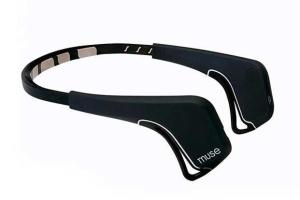 On 5 October 2013, over 500 adults participated in an experiment by neuroscientists at an arts festival in Canada, aimed at exploring the ability of humans to rapidly learn to control their brain states in a complex environment.
On 5 October 2013, over 500 adults participated in an experiment by neuroscientists at an arts festival in Canada, aimed at exploring the ability of humans to rapidly learn to control their brain states in a complex environment.The participants were invited in groups of 20 inside a 60ft geodesic dome, and asked to wear a wireless electroencephalography (EEG) headband. Named “Muse”, it is a clinical-grade EEG brain computer interface (BCI) headband that helps individuals become more aware of their brain activity and learn self-regulation of brain functions to fit their personal goals.
The participants began by playing a collective game, which required them to alternate between states of relaxation and concentration as defined by their own EEG recording.
After the game, they proceeded into a “dream experience”. There were four thematic libraries of “dream snippets”: animated video clips paired with pre-recorded musical clips. Each “dream” accessed one of the four libraries and composed the audio-video assets in real time, based on the collective neuro-feedback of all 20 participants.
The dreams were then projected on to the entire surface of the dome. The dream experience was further enhanced with live improvisations from three musicians inspired by the brain-triggered dream sequences. The participants simultaneously reacted to, and changed, the external environment.
The experiment, called “My Virtual Dream”, yielded a total of 577 data sets, of which 523 were fully usable—314 females and 209 males.
The neuroscientists, who were from the Toronto-based Rotman Research Institute, University of Toronto and Germany’s Max Planck Institute for Human Cognitive and Brain Sciences, published their findings in the journalPLoS ONE on 8 July.
They believe the results from the game sequence (the data from the dream experiment is not covered in the paper) not only demonstrated the scientific viability of collective neuro-feedback as a potential new avenue of neuroscience research that takes into account individuality, complexity and sociability of the human mind, but also yielded new evidence that neuro-feedback learning can have an effect on the brain almost immediately.
Natasha Kovacevic, creative producer of My Virtual Dream and programme manager of the Centre for Integrative Brain Dynamics at Rotman, said such experiments make sense because scientists run the risk of losing the “fine points of real-time brain activity that occur in a social life setting” in traditional lab settings.
The massive amount of EEG data that the neuroscientists extracted from the participants, showed that subtle brain activity changes were taking place “within approximately one minute of the neuro-feedback learning exercise”. People who were more relaxed just before the game (fewer beta waves) turned out to be better at learning concentration (increasing beta waves).
The art-science experiment was inspired by Baycrest’s ongoing international project to build the world’s first functional Virtual Brain—a research and diagnostic tool that neuroscientists at the academic health sciences institute believe could one day revolutionize brain healthcare. The scientists also hope to make the whole simulation system remotely accessible through a simple Web browser, including 3D visualization that does away with the need for supercomputers or large databases.
The researchers said they were inspired by user-involved research games like Foldit that hope to teach human strategies to computers and fold proteins (the process by which a protein structure takes its shape) faster to help combat disease-related proteins and cure diseases.
A similar crowdsourced astronomy game, Galaxy Zoo, also relies on “citizen scientists” to classify stars hundreds of light years away.
Efforts to understand, or map, the brain are an ongoing exercise in the scientific community.
On 9 July, Miguel Nicolelis, a professor of neurobiology and biomedical engineering at Duke University, US, published two separate papers, introducing a new paradigm for brain-machine interfaces that investigate how the brains of two or more animals (either monkeys or rats) can be networked to work together as part of a single computational system to perform motor tasks (in the case of monkeys) or simple computations (multiple rat brains).
Christening these networks of animal brains “brainets”, the authors suggest that brainets could serve as the core of organic computers that employ a hybrid digital-analogue computational architecture.
Scientists are also using games to infuse fun into such experiments.
For instance, in 2012, Sebastian Seung, a neuroscientist from the Massachusetts Institute of Technology, and his team recruited over 120,000 online gamers to help him map the brain by participating in a game called EyeWire.
Players are challenged to map branches of neurons from one side of a cube to the other, and reconstruct them with the help of an artificial intelligence algorithm developed at the Seung Lab. Their work is helping scientists understand how the brain sees movement.
Cutting Edge is a monthly column that explores the melding of science and technology.
